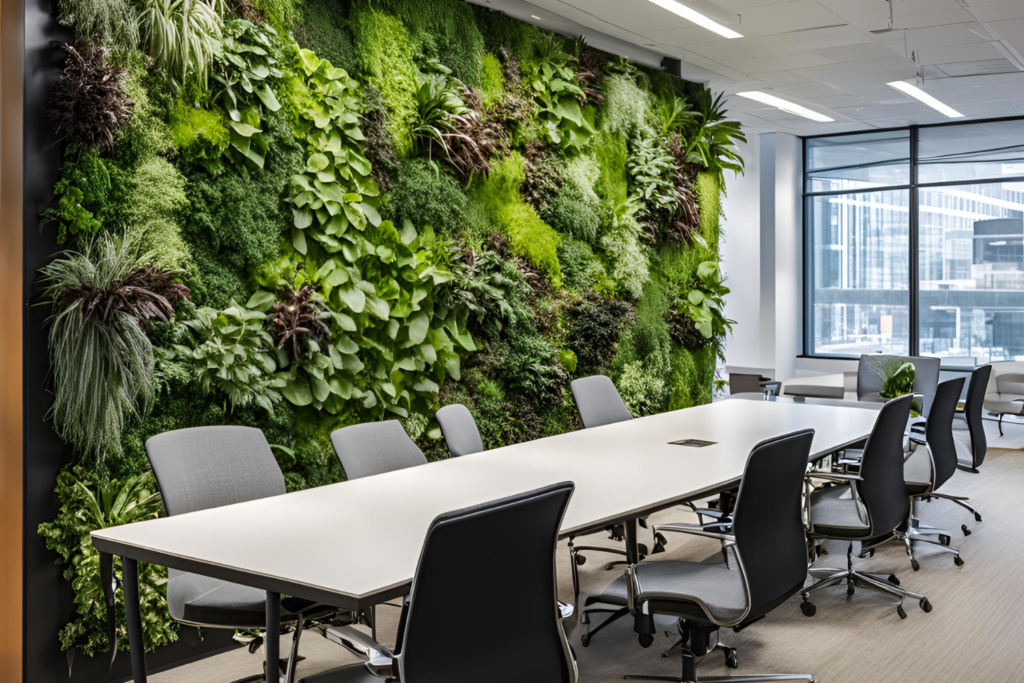On a global scale, buildings are responsible for 40% of the world’s CO₂ emissions, posing grave environmental concerns and health risks. And in dense urban areas like NYC, this number rises to a steep 70% [1]. Let’s explore how vertical gardens can contribute to our CO₂ reduction goals while also promoting energy conservation and improving air quality.
1. A Significant Carbon Offset
Green walls are not just aesthetically pleasing; they serve as a powerful tool for carbon offsetting. Studies have shown that green walls can absorb significant amounts of CO2, which contributes directly to a company’s carbon reduction goals. According to a study by Jozay et al, on average, a well-maintained green wall with plant species Vinca major, Sedum acre, and Frankenia thymifolia can offset between 23.44 – 28.66 kg CO2 m−2 per year [2].
Estimating Carbon Dioxide Absorption of a 250 sq ft Eco Brooklyn Living Wall in Manhattan
Eco Brooklyn’s living walls are designed using plant species like Vinca major that are proven to absorb CO₂ and significantly reduce a building’s carbon footprint. To estimate the pounds of carbon dioxide (CO₂) a 250 sq ft living green wall can absorb in a year with the assumption that it is planted with approximately 1 Vinca plant per square foot:
Average carbon offset per square meter per year = 23.44 kg CO2 m−2 per year
250 sq ft = 23.22 m−2
Average carbon offset by a 250 sq ft living wall = 23.44 x 23.22 = 544.27 kg CO2 per year = ~1120 pounds CO2 per year

Summary
A 250 sq ft living green wall containing one Vinca major plant per square foot is estimated to absorb approximately 1,120 pounds of carbon dioxide per year. Eco Brooklyn’s living walls commonly feature Vinca and other carbon-fixing plants alongside air-purifying plants [3] such as Spider Plant, Snake Plant, Peace Lily, Boston Fern, and Pothos. This combination provides the dual benefits of carbon fixation and enhanced air quality, creating a healthier and more sustainable environment.
2. Reducing Dependence on Non-Renewable Energy
Another remarkable benefit of green walls is their impact on energy consumption. A study highlighted the temperature regulation capabilities of green walls, noting an 8°C reduction in room temperature during hot summer days [4]. This significant temperature regulation can drastically reduce the need for air conditioning/heating, leading to lower energy consumption and, consequently, a reduction in reliance on non-renewable energy sources. By integrating green walls, companies can make a substantial impact on their energy footprint while also cutting operational costs.
3. Enhancing Air Quality
The benefits of green walls extend beyond carbon offset and energy efficiency. They also play a crucial role in improving indoor air quality. Green walls act as natural filters, trapping particulate matter and absorbing pollutants from the air. This leads to a healthier work environment, which can enhance employee productivity and well-being. Studies have demonstrated that green walls can significantly reduce harmful particulate matter. For PM2.5, reductions between 20.2% and 99.0% were found and for PM10, reductions between 23% and 60% have been reported, resulting in cleaner and safer air for everyone [4].
4. Aesthetic and Psychological Benefits
While the environmental benefits are substantial, the aesthetic appeal and psychological benefits of green walls cannot be overlooked. A green wall can transform a drab office space into a vibrant, inviting environment, fostering creativity and reducing stress. The presence of greenery has been shown to improve mood and boost overall employee satisfaction [5].
5. Alignment with CSR Goals
For companies committed to CSR, integrating green walls is a tangible way to demonstrate environmental stewardship and sustainability. Not only do green walls align with goals related to carbon reduction and energy efficiency, but they also contribute to broader objectives such as enhancing community well-being and supporting biodiversity. By showcasing their commitment to green design and technology, companies can also improve their public image and appeal to eco-conscious consumers and investors.
Conclusion
Living green walls offer an effective solution for reducing the carbon and energy footprint of buildings, which is the need of the hour in bustling urban settings like NYC. By significantly offsetting carbon emissions and lowering dependence on non-renewable energy, green walls contribute to a more sustainable operation of urban workspaces.
Living walls also enhance air quality and improve workplace aesthetics, making them a versatile and impactful choice for eco-conscious businesses. Investing in this green technology not only helps the environment but also supports employee well-being and bolsters corporate reputation. Adopting green walls could be a transformative step for your company, setting a new standard for environmental responsibility. To incorporate an eco-friendly green wall into your NYC office, contact Eco Brooklyn today!
References
[1] Zarco-Periñan, Pedro J & Zarco-Soto, Fco & Zarco-Soto, Irene & Martinez-Ramos, Jose & Sánchez-Durán, Rafael. (2022). CO2 Emissions in Buildings: A Synopsis of Current Studies. https://www.researchgate.net/publication/363517026_CO2_Emissions_in_Buildings_A_Synopsis_of_Current_Studies
[2] Jozay M, Zarei H, Khorasaninejad S, Miri T. Maximising CO2 Sequestration in the City: The Role of Green Walls in Sustainable Urban Development. Pollutants. 2024; 4(1):91-116. https://doi.org/10.3390/pollutants4010007
[3] CO2Meter. (n.d.). NASA compiles list of best plants to clean indoor air. CO2Meter. https://www.co2meter.com/ms-sg/blogs/news/nasa-compiles-list-of-best-plants-to-clean-indoor-air
[4] Cardinali, M., Balderrama, A., Arztmann, D., & Pottgiesser, U. (2023). Green walls and health: An umbrella review. Nature-Based Solutions, 3, 100070. https://doi.org/10.1016/j.nbsj.2023.100070
[5] ScienceDaily. (2014, September 1). Office plants can boost productivity. ScienceDaily. https://www.sciencedaily.com/releases/2014/09/140901090735.htm

